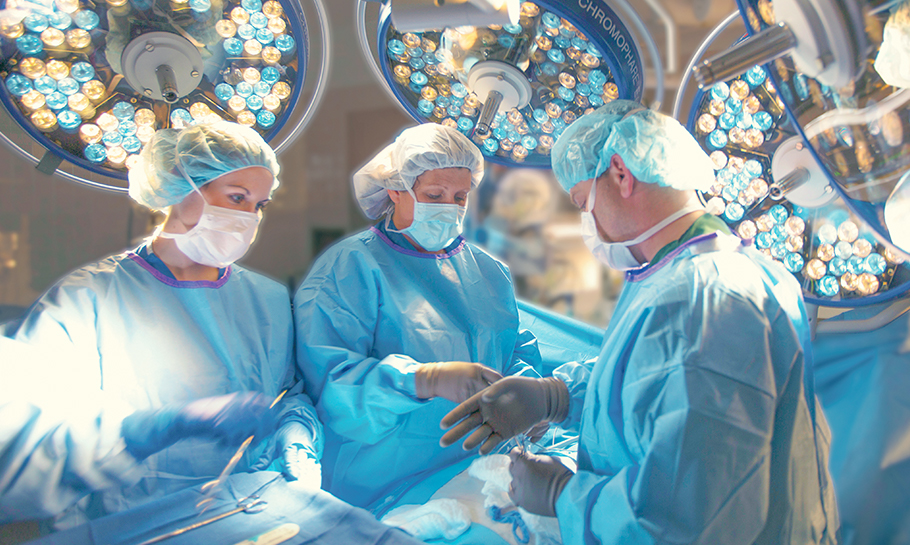Heart Procedures

Cardiac Interventions
For a cardiac intervention, physicians thread the catheter from an artery in the upper thigh or wrist to the heart. They can use angioplasty (a procedure to restore blood flow to the heart) to open the vessel and place a stent (a metal or plastic tube to keep the heart passageway open) if need be.Your physician will monitor your progress using live-imaging. These procedures take place in SIH Memorial Hospital of Carbondale’s cardiac catheterization lab.
Bypass Surgery
This type of surgery is used to reroute damaged arteries that supply blood to your heart muscle. It typically happens when coronary arteries become blocked or damaged. During this four to five-hour surgery, surgeons use a vein (often from the leg), to create a bypass around the blocked arteries. This makes sure your arteries are getting enough blood, which is essential to making sure your heart is working properly. These surgical procedures takes place at SIH Memorial Hospital of Carbondale.
TAVR (transcatheter aortic valve replacement)
This is an option for aortic valve replacement patients, who are at high surgical risk for valve replacement. The procedure fixes the valve without removing the damaged valve. TAVR is a minimally invasive option, where patients enjoy fewer nights in the hospital and faster recovery time. We’ve had hundreds of patients undergo this procedure and so many of them tell us their quality of life has improved dramatically because of it. Our team has successfully completed nearly 400 TAVR surgeries.
The first patients to undergo the TAVR surgery at SIH Memorial Hospital of Carbondale
Open-heart Valve Surgery
Valves between each of the heart's four pumping chambers keep blood flowing forward through the heart. Valves might need to be replaced if they become stiff or if they become leaky (meaning the blood leaks backward). Repairing or replacing valves within the heart takes the skill of a cardiovascular surgeon. In the heart’s complex operating system, sometimes the parts don’t work together properly. Valves can often be repaired, but sometimes require replacement altogether. Our team has over 20 years experience in aortic valve replacement.
SIH cardiothoracic surgeons perform a less invasive valve surgery called a mini AVR requiring minimal incision and minimal trauma.
In the past, when doctors needed to replace the aortic valve, they would do a procedure called "median sternotomy." This involved making a big 10- to 12-inch cut straight down the middle of the chest, and then opening the breastbone to reach the heart.
But now, we have a newer and less invasive way to do this surgery, called "mini-AVR." Instead of the large cut, the surgeon makes a much smaller 2- to 3-inch incision between the ribs on the right side of the chest. This smaller incision allows the surgeon to reach the heart without having to open the entire breastbone.
With the mini-AVR, the surgeon can still replace the faulty valve with an artificial one, using a technique called the "parachute technique." This means they carefully sew the new valve in place, ensuring it functions properly.
The mini-AVR is a safer and quicker option, and it allows for a faster recovery. This means you can get back to your normal activities sooner. Your doctor will help determine if this procedure is right for you. Remember, medical advancements like the mini-AVR are here to help you get better with less disruption to your daily life.
PFO and ASD Closure - Minimally Invasive Treatments
For certain types of congenital heart disease in adults, we have advanced ways to repair them without open-heart surgery. Instead, we use thin, flexible tubes called catheters to perform the treatment. These catheter-based procedures allow us to fix the heart defect without making a big incision.
Here's how it works: Your healthcare provider inserts the catheter through a blood vessel, usually in the groin area, and gently guides it to your heart. Sometimes, more than one catheter is used. Once the catheter is in place, the doctor uses tiny tools passed through the catheter to repair the congenital heart issue.
Pulmonary Embolus Breakdown/Removal:
During a catheter-assisted thrombolysis treatment, we use a catheter to reach the location of the blood clot through the blood vessels. The catheter delivers a special clot-dissolving medicine called thrombolytics, which helps dissolve the clot. To make this treatment even more effective and safe, we use an advanced device called EKOS.
The EKOS device is cutting-edge technology that uses ultrasound to deliver very low doses of a clot-dissolving drug directly into the clot through the catheter. This process rapidly clears the clot while significantly reducing the risk of bleeding. The ultrasound waves make the clot porous, allowing the clot-dissolving drug to be absorbed quickly, speeding up the dissolving process and restoring blood flow faster.
INARI Flowtriever - A Powerful Solution:
With the INARI Flowtriever, a catheter is guided through the blood vessels to reach the location of the blood clot. This special equipment can capture and remove the clot burden from larger blood vessels. The best part is that this procedure can be done in a single session, eliminating the need for intravenous blood thinners and an intensive care stay.
These minimally invasive treatments offer safer and faster ways to deal with heart issues and blood clots. They help you recover quicker, and you may not need to stay in the hospital for a long time. Your healthcare provider will discuss the best treatment option for you based on your specific condition. With these advanced procedures, we aim to provide you with effective care while minimizing any disruptions to your daily life.